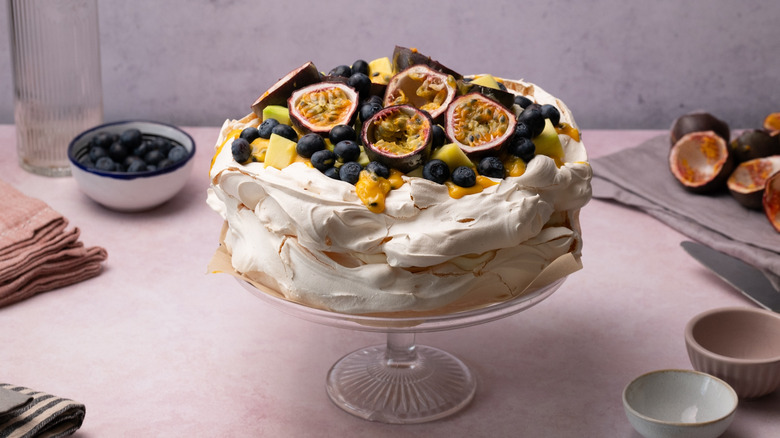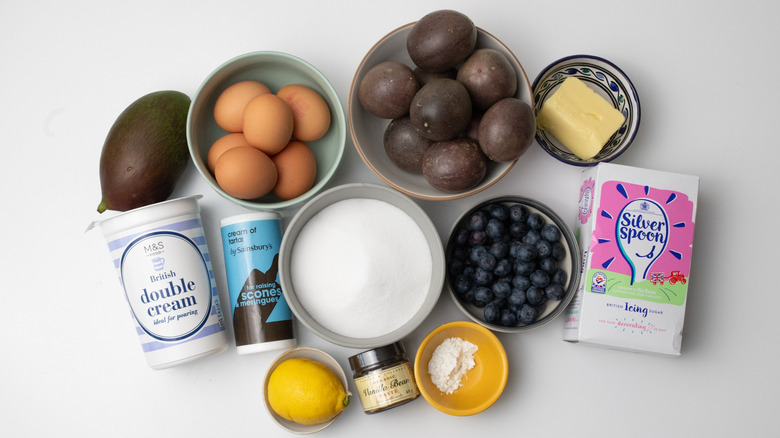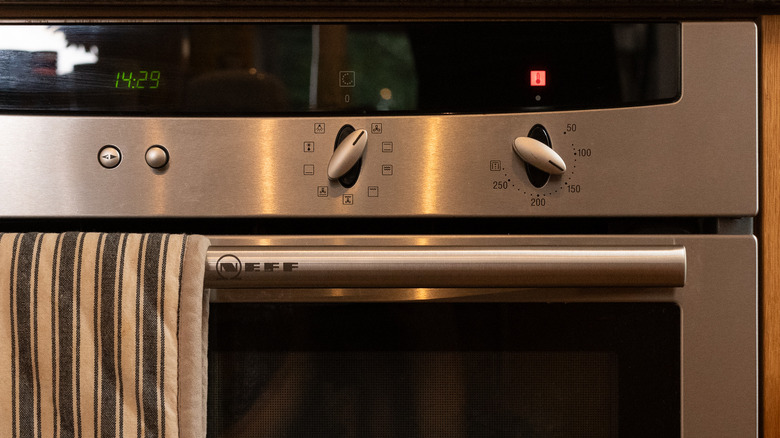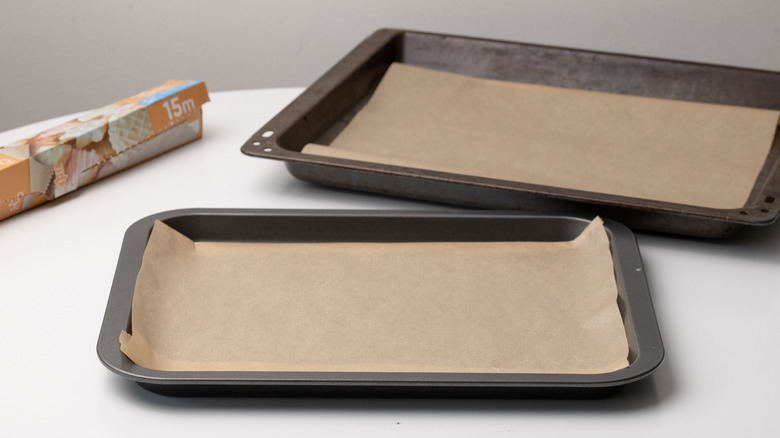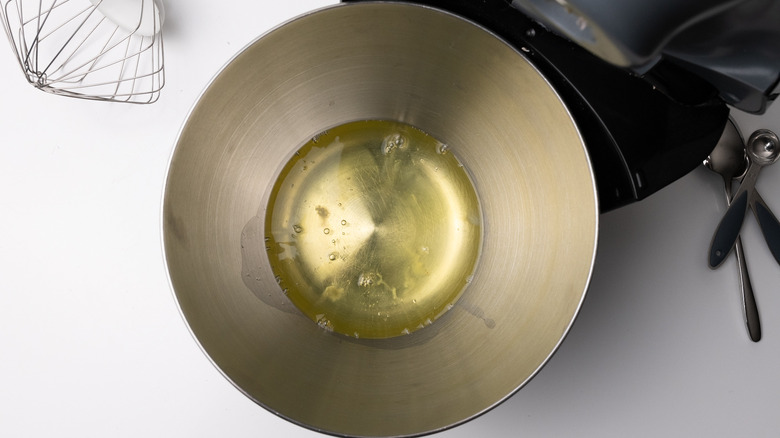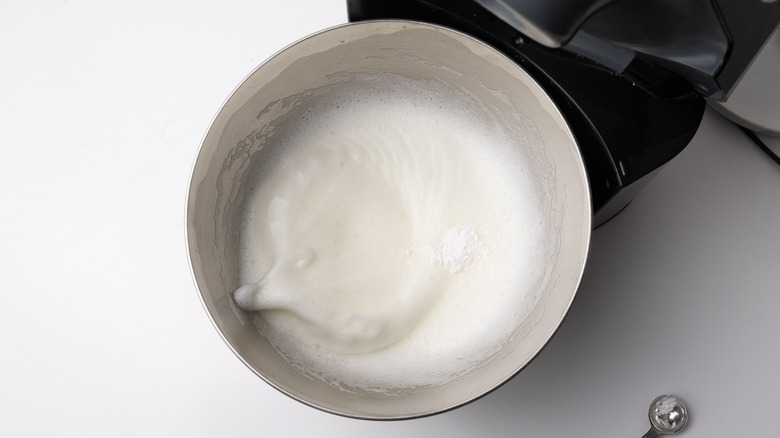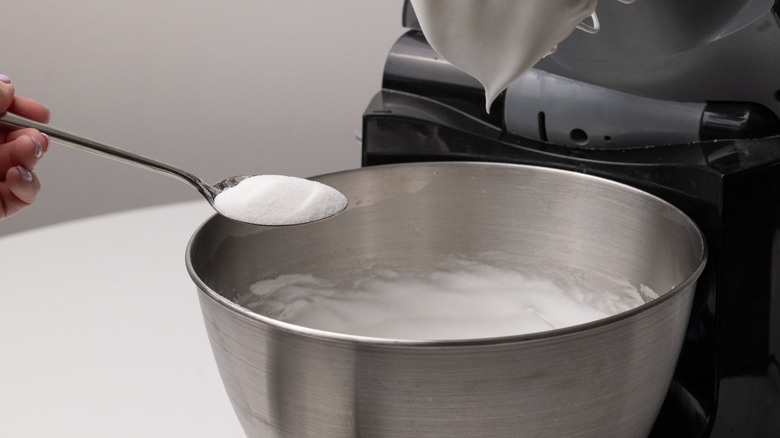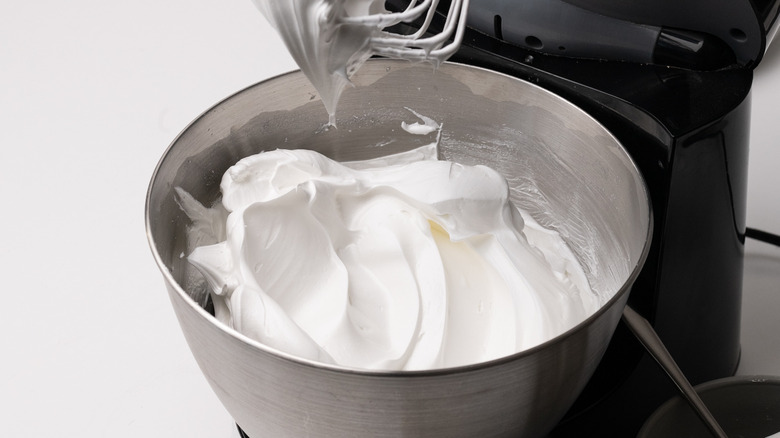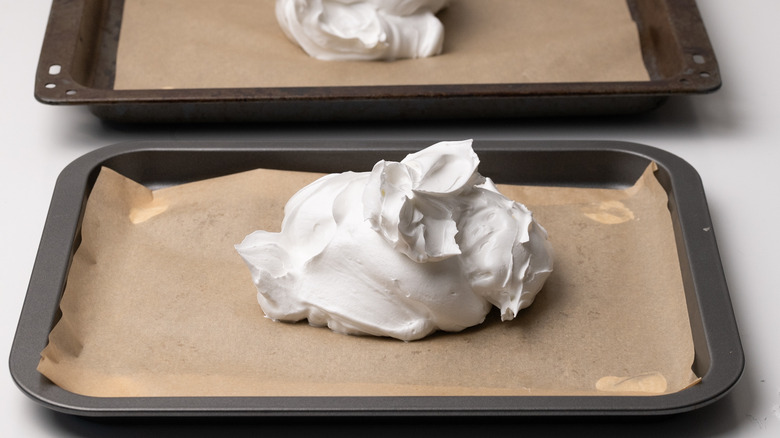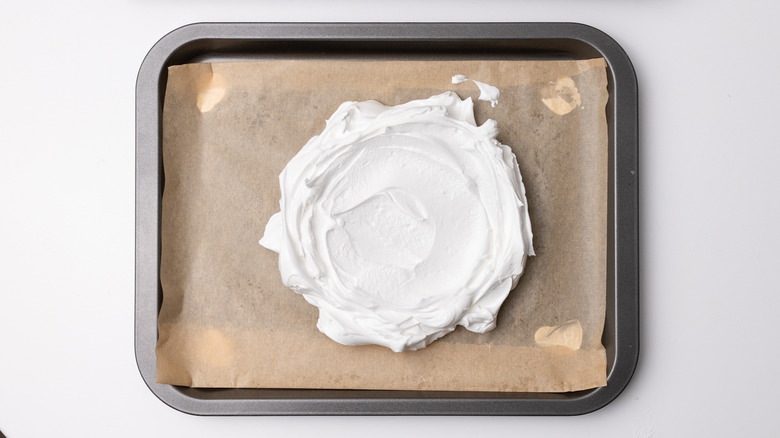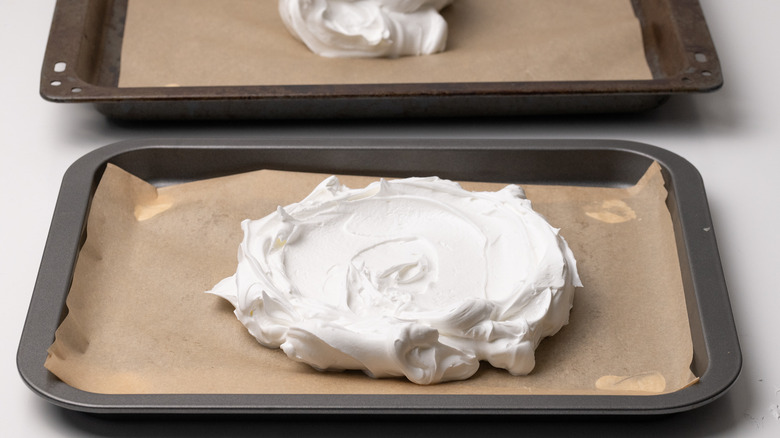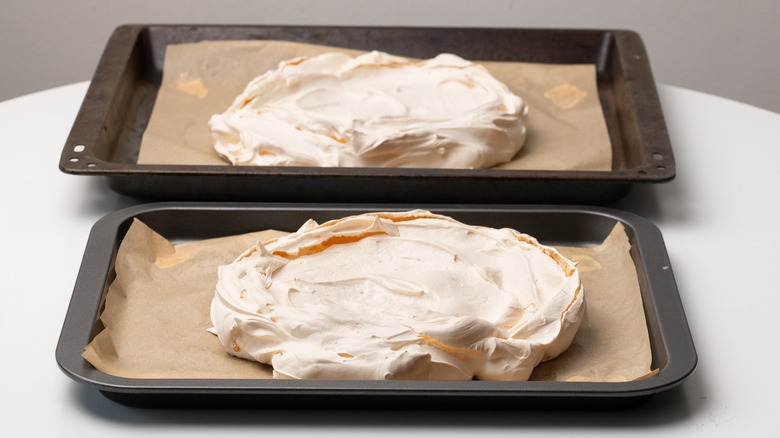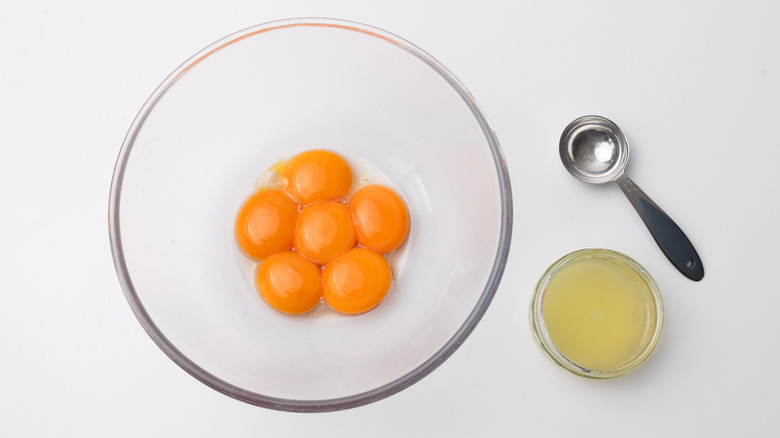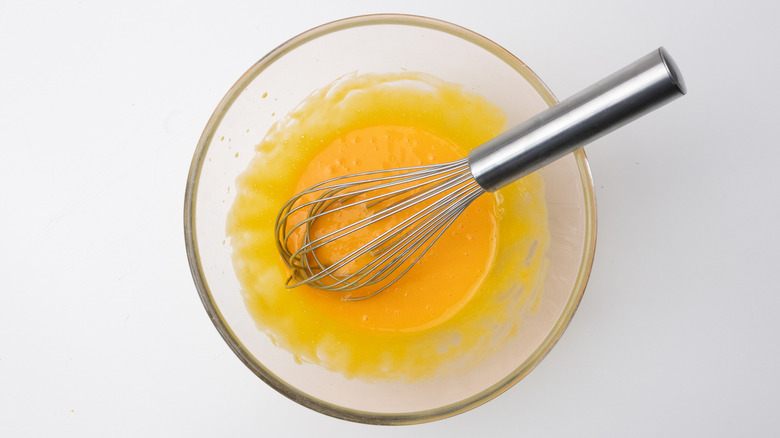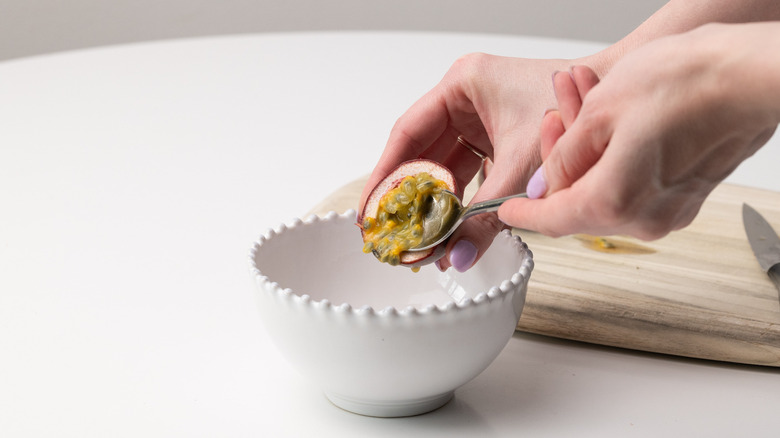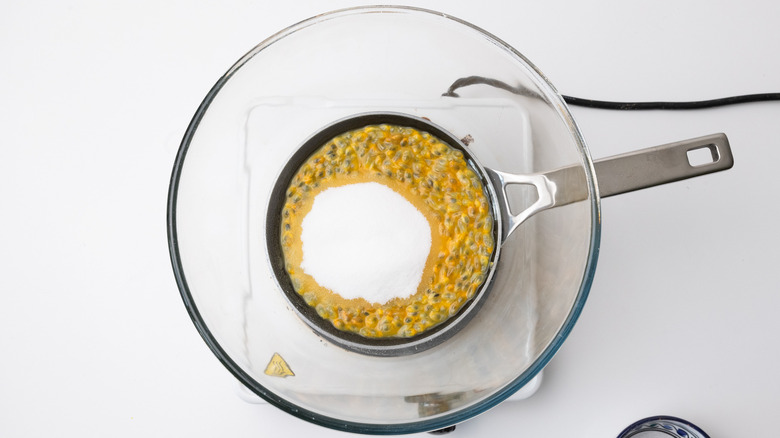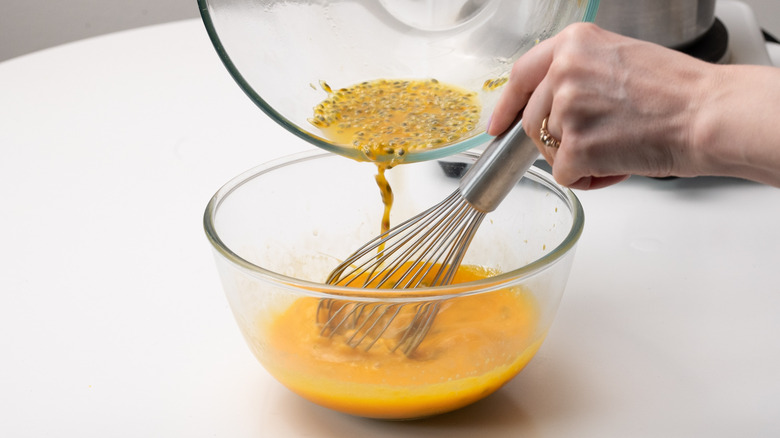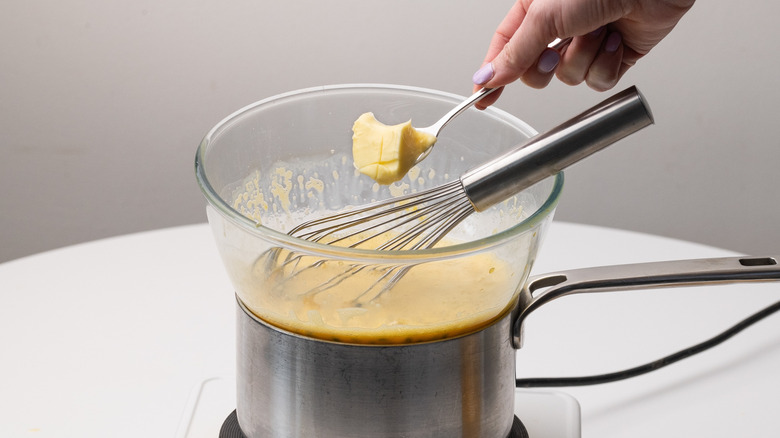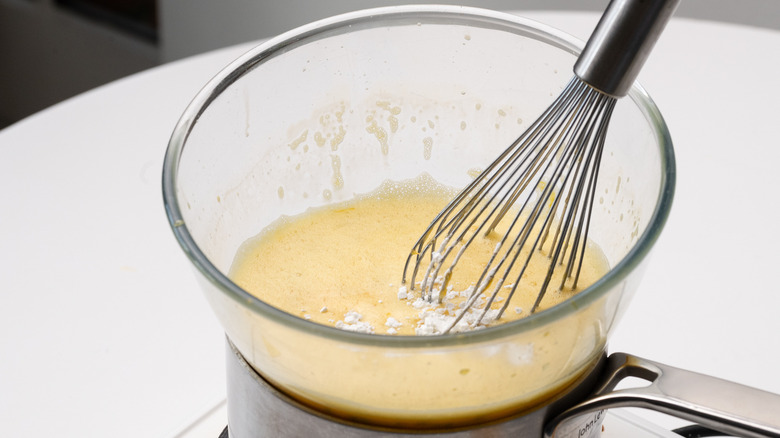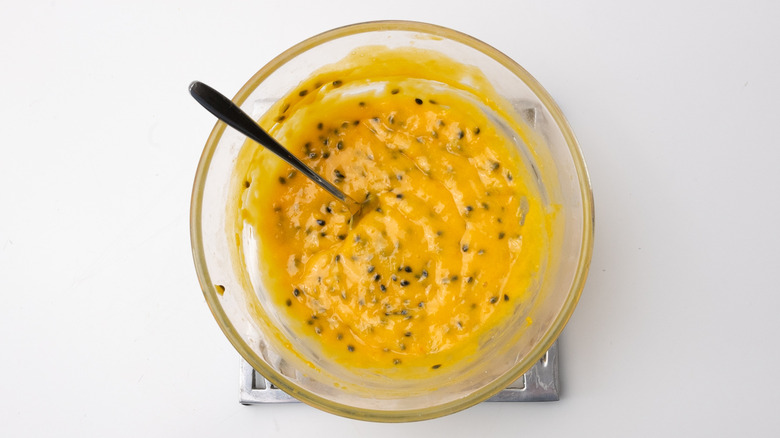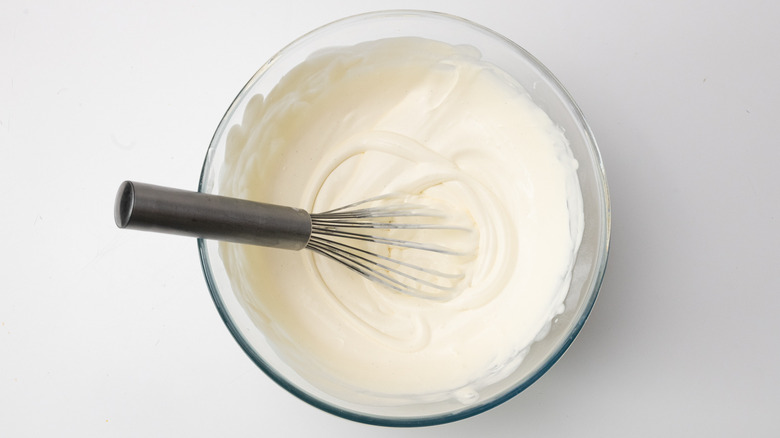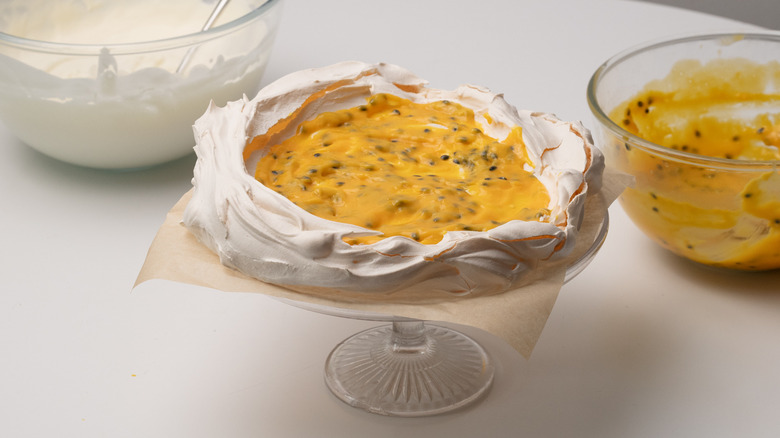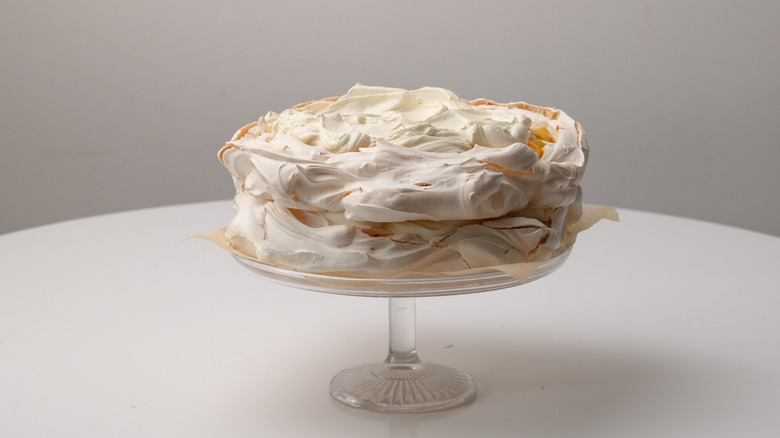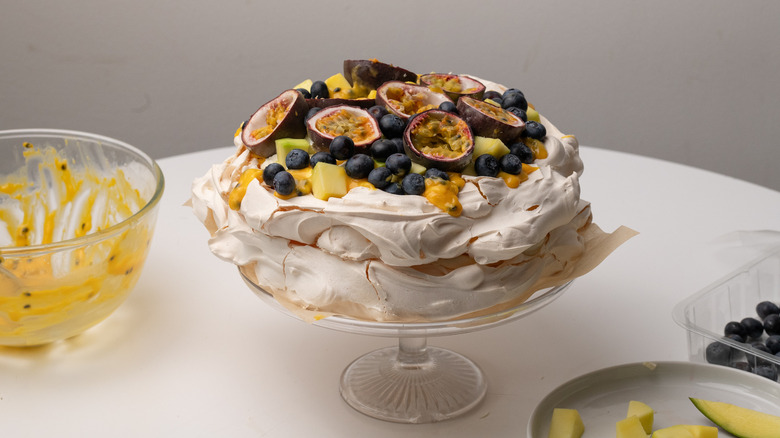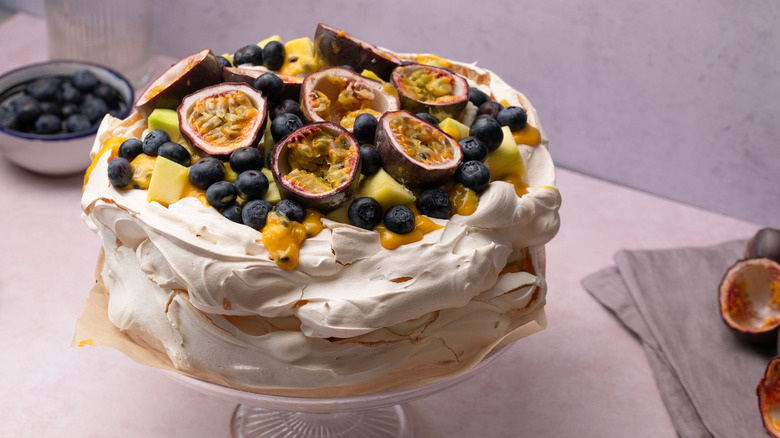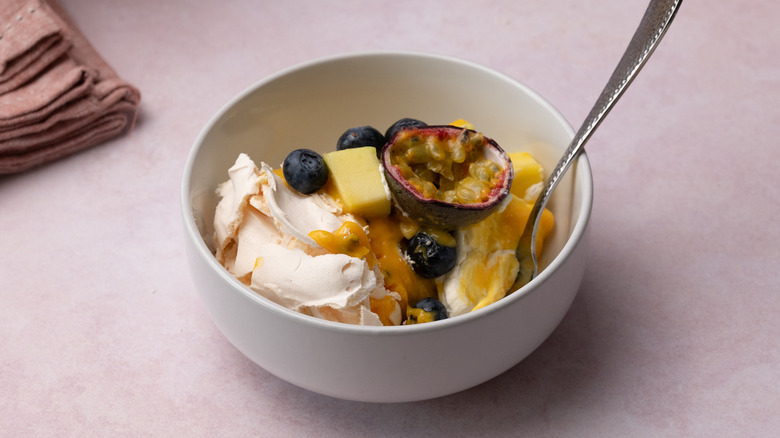Tropical Passion Fruit Pavlova Recipe
If delicate elegance bursting with vibrant fruity flavors is your thing, then look no further than this tropical passion fruit pavlova recipe created by Tasting Table recipe developer Jennine Rye. Though there is some debate over which country truly invented the classic pavlova, it is commonly accepted that this popular dessert got its name from famed Russian ballerina Anna Pavlova, as people likened the airy delicate meringue-and-cream-based creation to her lightness and elegance on stage.
This tropical passion fruit pavlova boasts two layers of meringue with perfectly soft marshmallowy centers and a crisp outer shell. Sandwiched between the meringues is a wonderfully sweet and tart homemade passion fruit curd, as well as lashings of softly whipped vanilla cream. The pavlova is topped with further passion fruit curd and cream, before being decorated with a mixture of fresh mango, juicy blueberries, and more zingy passion fruit. This pavlova provides a different fruity option than the classic berry-topped version and is a great alternative to cake for any celebration. It is an especially wonderful dessert for the warm summer months due to its light texture and bright tropical flavors.
Gather the ingredients for this tropical passion fruit pavlova recipe
To begin this tropical passion fruit pavlova recipe, first you will need to gather the ingredients. For the pavlova, you will want egg whites, cream of tartar, and superfine sugar, which is also known as caster sugar or baker's sugar. If you are unable to find this, granulated sugar will also work at a pinch. For the passion fruit curd, you will need egg yolks, lemon juice, passion fruit, more sugar, cornstarch, and butter. To assemble the pavlova you will also want whipping cream, confectioner's sugar, vanilla seed paste, more fresh passion fruit, mango, and blueberries.
Step 1: Preheat the oven
Preheat the oven to 350 F.
Step 2: Prepare a baking sheet
Line a large baking sheet with parchment paper.
Step 3: Beat the egg whites
In a stand mixer, beat the egg whites until soft peaks form.
Step 4: Add the cream of tartar
Add the cream of tartar along with a tablespoon of sugar, and beat.
Step 5: Add the sugar
Leaving the stand mixer on, slowly feed the rest of the sugar into the mixture a tablespoon at a time, allowing it to be fully incorporated into the meringue before adding the next tablespoon.
Step 6: Beat until smooth
Once all of the sugar has been added, keep beating the mixture until it feels smooth between your fingers.
Step 7: Divide the meringue
Divide out the meringue mixture into two heaps on the baking sheet.
Step 8: Shape the meringue
Using a spoon or a knife, mold the heaps into two circular shapes of roughly 8 inches with dips in the middle.
Step 9: Transfer the meringues to the oven
Transfer the meringues to the oven and immediately reduce the temperature to 300 F.
Step 10: Bake the meringues
Bake the meringues for 1 hour, then turn the heat off and allow the meringues to cool completely before taking them out of the oven, 4 to 6 hours or overnight.
Step 11: Whisk the egg yolks
To make the passion fruit curd, whisk together the egg yolks and the lemon juice.
Step 12: Set the yolks aside
Set to one side.
Step 13: Remove the passion fruit pulp
Slice each passion fruit in half and scoop out the pulp, including the seeds. You should end up with about 1 cup of pulp.
Step 14: Combine the passion fruit and sugar
In a bain-marie over a low heat, gently heat the passion fruit pulp and the sugar, until the sugar has completely dissolved.
Step 15: Combine the egg yolks and passion fruit
Remove the passion fruit mixture from the heat, and slowly pour it into the egg mixture, whisking all the while.
Step 16: Add the butter
Return the warm passion fruit mixture to the low heat, and gradually whisk in the butter a tablespoon at a time, to emulsify it.
Step 17: Add the cornstarch
Whisk in the cornstarch.
Step 18: Let the curd thicken
Once the mixture has thickened, after 8 – 10 minutes, remove it from the heat and set it aside to cool.
Step 19: Whip the cream
In a large bowl, whisk together the whipping cream, confectioners' sugar, and vanilla seed paste to form soft peaks.
Step 20: Assemble the pavlova
To assemble the pavlova, place one of the cooled meringues onto a plate or cake stand, and fill it with half of the passion fruit curd and half of the whipped cream.
Step 21: Finish assembly of the pavlova
Place the second meringue on top, and repeat the process, to use up the passion fruit curd and cream.
Step 22: Decorate and serve the pavlova
Decorate the pavlova with the remaining passion fruit, mango, and blueberries, before serving.
How can this pavlova recipe be switched up?
Although whipping up a good meringue can be an intimidating activity, once you've nailed the basics there are plenty of ways you can jazz up this tropical passion fruit pavlova recipe. For more flavor in your meringue layers, you can incorporate either lemon or lime zest to enhance the fruity taste of the dessert, or you could add an extract such as vanilla, almond, or orange to give a new flavor dimension to the meringue shell. For a simpler approach, instead of cooking two layers of meringue, you can cook one larger, thicker meringue layer, and then heap the cream, passion fruit curd, and tropical fruits on the top.
Why not add some different flavorings to the whipped cream? For even more of a fruity hit, you could add citrus zest or blended berries to the mixture. Or, for more of an adult finish, you could mix in a fruity liquor or even coconut rum. The tropical fruits used to decorate the pavlova can really change the flavor of the finished product, so use the fruits that are in season at your supermarket and experiment with different combinations. Pineapple and papaya are both delicious additions, as are kiwi and dragon fruit. To finish off, fresh herbs such as mint look and taste great on this pavlova, and, if you are serving it for a special occasion, edible flowers are a beautiful addition and make the dessert even prettier.
How do you prepare passion fruit?
If you haven't come across passion fruit before, you may be a little unsure of how best to approach working with it. Passion fruit may be small, but its flavor is intense and distinctive. To taste, it is sweet, tart, and tropical-flavored fruit with subtle floral notes. To consume passion fruit, you can simply cut them in half and scoop out the vibrant pulp. The small black seeds are edible and have a wonderful crunch, however, the skin is tough and inedible and should be discarded. Passion fruit can also come in different colors, though the most commonly sold and consumed passion fruit has a purple skin.
For this recipe you will want to make sure you are using ripe passion fruit, so they are at their most juicy and flavorful. You can tell the ripeness of a passion fruit by how heavy it feels in your hand. If it is light, it will need some time to mature. If it feels plump and heavy, it is ripe and ready to go. While it is perfectly safe to eat passion fruit before it has reached its most ripe point, the pulp will be more tart. Similarly, wrinkly skin can indicate that passion fruit is deliciously ripe and juicy, but if you see any mold or other visible signs of spoilage, it might be past ripe to rotten.
Tropical Passion Fruit Pavlova Recipe
For an unusual twist on a classic pavlova, try this elegant passion fruit curd version, bursting with tropical flavor and topped with vanilla whipped cream.
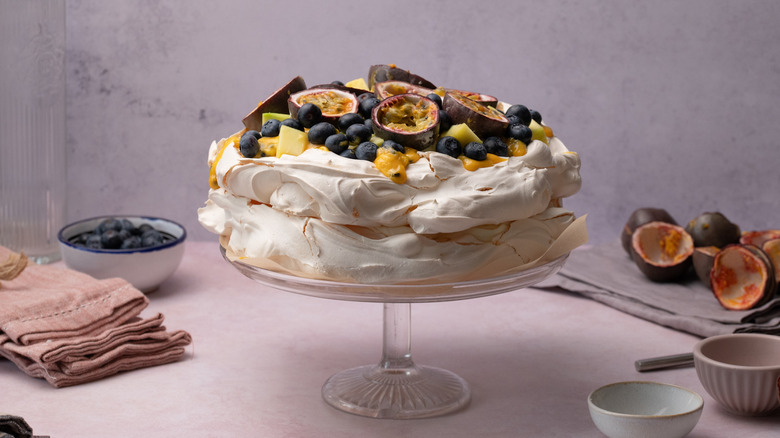
Ingredients
- For the pavlova
- 6 large egg whites, room temperature
- 1 teaspoon cream of tartar
- 1 ½ cups superfine sugar
- For the passion fruit curd
- 6 egg yolks
- 2 tablespoons lemon juice
- 8 passion fruit
- 6 tablespoons superfine sugar
- 1 teaspoon cornstarch
- 6 tablespoons butter
- To assemble the pavlova
- 2 ½ cups whipping cream
- 2 tablespoons confectioner's sugar
- 1 teaspoon vanilla seed paste
- To decorate
- 3 - 4 whole passion fruit, to decorate
- 1 fresh mango, sliced
- ¼ cup fresh blueberries
Directions
- Preheat the oven to 350 F.
- Line a large baking sheet with parchment paper.
- In a stand mixer, beat the egg whites until soft peaks form.
- Add the cream of tartar along with a tablespoon of sugar, and beat.
- Leaving the stand mixer on, slowly feed the rest of the sugar into the mixture a tablespoon at a time, allowing it to be fully incorporated into the meringue before adding the next tablespoon.
- Once all of the sugar has been added, keep beating the mixture until it feels smooth between your fingers.
- Divide out the meringue mixture into two heaps on the baking sheet.
- Using a spoon or a knife, mold the heaps into two circular shapes of roughly 8 inches with dips in the middle.
- Transfer the meringues to the oven and immediately reduce the temperature to 300 F.
- Bake the meringues for 1 hour, then turn the heat off and allow the meringues to cool completely before taking them out of the oven, 4 to 6 hours or overnight.
- To make the passion fruit curd, whisk together the egg yolks and the lemon juice.
- Set to one side.
- Slice each passion fruit in half and scoop out the pulp, including the seeds. You should end up with about 1 cup of pulp.
- In a bain-marie over a low heat, gently heat the passion fruit pulp and the sugar, until the sugar has completely dissolved.
- Remove the passion fruit mixture from the heat, and slowly pour it into the egg mixture, whisking all the while.
- Return the warm passion fruit mixture to the low heat, and gradually whisk in the butter a tablespoon at a time, to emulsify it.
- Once the mixture has thickened, after 8 - 10 minutes, remove it from the heat and set it aside to cool.
- In a large bowl, whisk together the whipping cream, confectioners' sugar, and vanilla seed paste to form soft peaks.
- To assemble the pavlova, place one of the cooled meringues onto a plate or cake stand, and fill it with half of the passion fruit curd and half of the whipped cream.
- Place the second meringue on top, and repeat the process, to use up the passion fruit curd and cream.
- Decorate the pavlova with the remaining passion fruit, mango, and blueberries, before serving.
